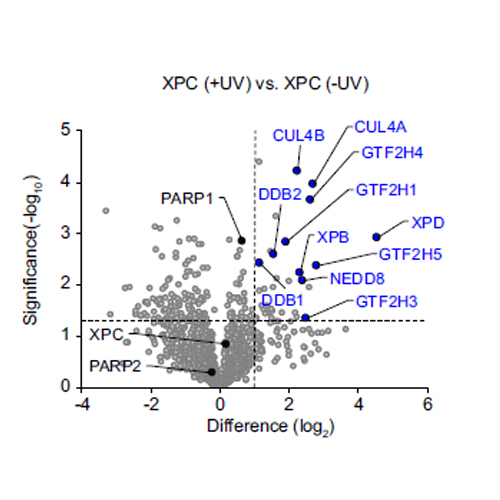XPC–PARP complexes engage the chromatin remodeler ALC1 to catalyze global genome DNA damage repair
2022-08-13
Charlotte Blessing, Katja Apelt, Diana van den Heuvel, Claudia Gonzalez-Leal, Magdalena B. Rother, Melanie van der Woude, Román González-Prieto, Adi Yifrach, Avital Parnas, Rashmi G. Shah, Tia Tyrsett Kuo, Daphne E. C. Boer, Jin Cai, Angela Kragten, Hyun-Suk Kim, Orlando D. Schärer, Alfred C. O. Vertegaal, Girish M. Shah, Sheera Adar, Hannes Lans, Haico van Attikum, Andreas G. Ladurner & Martijn S. Luijsterburg
Nat Commun 13, 4762, 2022
Cells employ global genome nucleotide excision repair (GGR) to eliminate a broad spectrum of DNA lesions, including those induced by UV light. The lesion-recognition factor XPC initiates repair of helix-destabilizing DNA lesions, but binds poorly to lesions such as CPDs that do not destabilize DNA. How difficult-to-repair lesions are detected in chromatin is unknown. Here, we identify the poly-(ADP-ribose) polymerases PARP1 and PARP2 as constitutive interactors of XPC. Their interaction results in the XPC-stimulated synthesis of poly-(ADP-ribose) (PAR) by PARP1 at UV lesions, which in turn enables the recruitment and activation of the PAR-regulated chromatin remodeler ALC1. PARP2, on the other hand, modulates the retention of ALC1 at DNA damage sites. Notably, ALC1 mediates chromatin expansion at UV-induced DNA lesions, leading to the timely clearing of CPD lesions. Thus, we reveal how chromatin containing difficult-to-repair DNA lesions is primed for repair, providing insight into mechanisms of chromatin plasticity during GGR.








